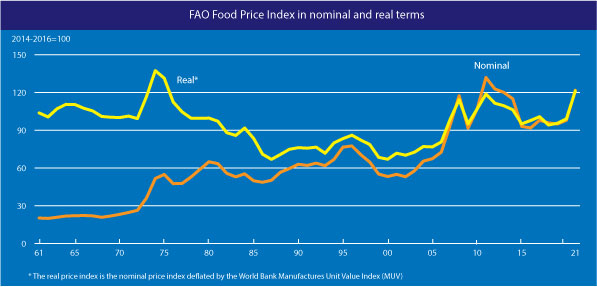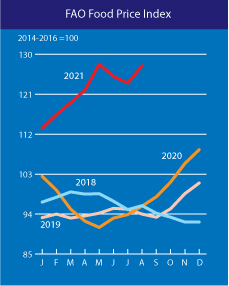And in inflation adjusted terms the highest since the early '70's "Great Grain Robbery" by the Soviets and the Oil Price Shock:

From the Food And Agriculture Organization, September 2:
The FAO Food Price Index rebounded rapidly in August
» The FAO Food Price Index (FFPI) averaged 127.4 points in August 2021, up 3.9 points (3.1 percent) from July and 31.5 points (32.9 percent) from the same period last year. The FFPI’s rebound in August after two consecutive months of decline was led by strong gains in the sugar, vegetable oils, and cereal sub-indices.

» The FAO Cereal Price Index averaged 129.8 points in August, up 4.3 points (3.4 percent) from July and 30.8 points (31.1 percent) above its August 2020 level. Reduced harvest expectations in several major exporting countries pushed up world wheat prices by 11.1 points (8.8 percent) month-on-month, to 41.5 points (43.5 percent) above their level of one year ago. Among other cereals, price trends were mixed in August. Lower barley production outlooks, especially in Canada and the United States of America, and spillover from rising wheat prices pushed up international barley values by 10.9 points (9.0 percent) since July, to 34.7 points (35.6 percent) above their levels of one year ago. By contrast, maize prices registered a slight decline of 1.3 points (0.9 percent). Improved production prospects in Argentina, the EU, and Ukraine moderated the effects of lowered production forecasts in Brazil and the United States of America. International sorghum quotations also fell in August, by 3.9 points (2.5 percent), though still up 45.5 points (43.3 percent) from the same period last year. Meanwhile, international rice prices remained on a downward trajectory in August, influenced by efforts to promote foreign sales as well as currency movements.
» The FAO Vegetable Oil Price Index averaged 165.7 points in August, rebounding by 10.3 points (or 6.7 percent) from July’s five-month low. The recovery mainly reflected higher palm, rapeseed and sunflowerseed oil prices. In August, international palm oil quotations reverted to recent historic highs, largely underpinned by protracted concerns over below-potential production and resulting inventory drawdowns in Malaysia. In the meantime, rapeseed oil prices received support from firm demand in the European Union, amid prospects of tightening global supplies. As for sunflower oil, international price quotations firmed markedly after falling two months in a row, mainly fuelled by limited export availabilities in the Black Sea region before the 2021/22 harvests reach the market.
» The FAO Dairy Price Index averaged 116.0 points in August, down marginally from July but still 13.9 points (13.6 percent) above its value in the corresponding month last year. In August, international quotations for milk powders fell, reflecting the continued weakness in global import demand for spot supplies combined with seasonally rising export availabilities in Oceania during the new production season. By contrast, price quotations for cheese rose, underpinned by increased internal demand and tightened supplies in Europe, offset by a slight decline in prices in Oceania on rising production. Butter prices also rose slightly, pressured by high import demand from East Asia for near-term deliveries.
» The FAO Meat Price Index* averaged 112.5 points in August, up slightly from July, placing the index 20.3 points (22.0 percent) above its value in the corresponding month last year. In August, international quotations for ovine and bovine meats increased, principally underpinned by high purchases, mainly by China, and constrained supplies of animals for slaughter in Oceania. Poultry meat prices also rose, reflecting solid import demand from East Asia and the Middle East and limited production expansions in some major exporting countries owing to high input costs and labour shortages. By contrast, pig meat prices fell due to China's continued decline in purchases and weak internal demand in Europe amidst a slight increase in the supply of slaughter-ready pigs....
....MUCH MORE